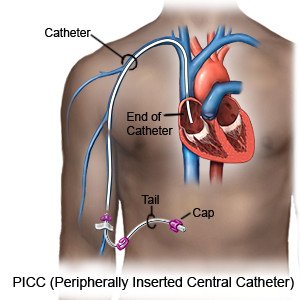Picc (Peripherally Inserted Central Catheter)
Medically reviewed by Drugs.com. Last updated on Aug 4, 2025.
A PICC is a catheter (small tube) used to give treatments and to take blood. The catheter is inserted into an arm vein. These veins are called peripheral veins. The catheter is guided through the peripheral vein into a central vein near your heart.
 |
DISCHARGE INSTRUCTIONS:
Call your local emergency number (911 in the US) for any of the following:
- You feel pain in your arm, neck, shoulder, or chest.
- You cough up blood.
Seek care immediately if:
- The catheter site turns cold, changes color, or you cannot feel it.
- You see blood on your dressing and the amount is increasing.
- The veins in your neck or chest bulge.
Call your doctor if:
- You see signs of infection, such as redness, swelling, or pus, or you have a fever.
- The catheter site is red, warm, painful, or oozing fluid.
- You see blisters on the skin near the catheter site.
- You cannot flush your catheter, or you feel pain when you flush your catheter.
- You see that the catheter is getting shorter, or it falls out. Put pressure on the site with a clean towel before you call your doctor.
- You see a hole or a crack in your catheter. Clamp your catheter above the damage before you call your doctor.
- You have questions or concerns about your catheter.
Medicines:
- NSAIDs help decrease swelling and pain or fever. This medicine is available with or without a doctor's order. NSAIDs can cause stomach bleeding or kidney problems in certain people. If you take blood thinner medicine, always ask your healthcare provider if NSAIDs are safe for you. Always read the medicine label and follow directions.
- Take your medicine as directed. Contact your healthcare provider if you think your medicine is not helping or if you have side effects. Tell your provider if you are allergic to any medicine. Keep a list of the medicines, vitamins, and herbs you take. Include the amounts, and when and why you take them. Bring the list or the pill bottles to follow-up visits. Carry your medicine list with you in case of an emergency.
Self-care:
- Plan to rest when you get home. You should be able to go back to your normal activities the next day. Your healthcare provider will tell you which activities are okay for you.
- Apply a warm compress as directed. The area where the catheter was inserted may feel sore. A warm compress can help to decrease pain and swelling in your arm. Wet a small towel with warm water. Wring out the extra water. Wrap the cloth in plastic, and put it on the area. Use the compress 4 times a day, for 10 minutes each time. Prop your arm up on pillows when you are sitting or lying down. This will decrease swelling.
- Follow instructions on how to care for your insertion site. Your provider will tell you when it is okay to shower or bathe. This is usually after about 1 week. You will need to keep the area covered so it stays dry when you bathe.
Prevent an infection:
The area around your catheter may get infected, or you may get an infection in your bloodstream. A bloodstream infection is called a central line-associated bloodstream infection (CLABSI). A CLABSI is caused by bacteria getting into your bloodstream through your catheter. This can lead to severe illness. The following are ways you can help prevent an infection:
- Wash your hands often. Use soap or an alcohol-based hand rub to clean your hands. Clean your hands before and after you touch the catheter or the catheter site. Remind anyone who cares for your catheter to wash his or her hands.

- Limit contact with the catheter. Do not touch or handle your catheter unless you need to care for it. Do not pull, push on, or move the catheter when you clean your skin or change the dressing. Wear clean medical gloves when you touch your catheter or change dressings.
- Clean your skin as directed. Clean the skin around your catheter every day and before you change your dressing. Ask your healthcare provider what to use to clean your skin. Check your skin every day for signs of infection, such as pain, redness, swelling, and oozing. Contact your healthcare provider if you see these signs.
- Change the dressing as directed. Keep a sterile dressing over the catheter site. Change the dressing as directed or when it is loose, wet, dirty, or falls off. Clean the skin under the dressing with the solution your healthcare provider suggests. Let the area dry before you put on the new dressing. Do not blow on your skin to help it dry.
- Keep the area dry. Wrap your arm with plastic and seal it with medical tape before you bathe. Take showers instead of baths. Do not swim or soak in a hot tub.
Follow up with your doctor as directed:
Write down your questions so you remember to ask them during your visits.
© Copyright Merative 2025 Information is for End User's use only and may not be sold, redistributed or otherwise used for commercial purposes.
The above information is an educational aid only. It is not intended as medical advice for individual conditions or treatments. Talk to your doctor, nurse or pharmacist before following any medical regimen to see if it is safe and effective for you.
Further information
Always consult your healthcare provider to ensure the information displayed on this page applies to your personal circumstances.
